Normandy: Muffled Drums
We sped out of Paris faster than you could say “Peripherique,” the mighty ring road around the city, and zoomed into the countryside, the glorious countryside made golden by an abundant summer sun and paint-worthy by the proffered harvest of yellow butter-balls of hay lobbed into fields Van Gogh like even with those big black crows in the fields beside them. All looked right for Rumpelstiltskin to do his spinning. And as though breaking through my thoughts of gain and gloss, my wife turned to me and Tom Cruise like saying brusquely, “Show me the Monet.”
Now the Seine in these parts is a slow, slithering meanderer, cutting through chalk hills all forested as thickly as an Afro hairdo. We turned at the signs to Giverny, the pithily picture-book pretty village of Claude Monet’s last home, brought from the benefits of his fame. Its water-gardens below the house, its iconic green wooden bridge and lily ponds are now synonymous with Impressionism of which Monet was its founding member. And like us, turn too did the car-loads, and the bus loads and I am sure some even came by river … well that was my impression.
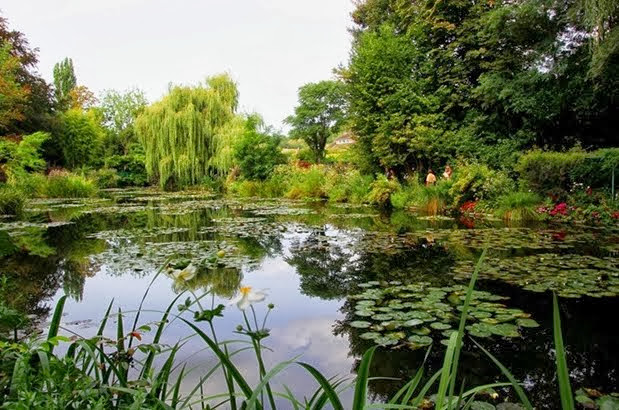
Monet’s famously painted water gardens at Giverny
The quaint houses and barns set beside narrow streets full of hanging floral baskets at every window, as though each day it all has to be at its best for the never-ending photo shoots, visually relaxing. If you can ignore the tourist bees a-buzzin,’ the village retains its quiet charm and it is easy to envisage the bowed, bearded, and bereted Claude, with his painting easel and board, shuffling through his stupendous flower garden and down to the water gardens, a collection of ponds fed by streams which wrinkle towards the Seine. It must have been oh so peaceful. His second wife commented that he was always “painting the same things” including the nearby Rouen cathedral. “You don’t understand” he told her, “I am trying to paint the air in between.” The ‘objects’ of his vision changed continuously in their adaption to the light, so giving subjects their ‘true value,’ the so-called “en plein air” air style of painting. But over the years Monet’s hues changed too, with more reddish tones, something later attributed by his aficionados as the work of cataracts in his eyes.’ But after an operation, his brilliant blues came back again.
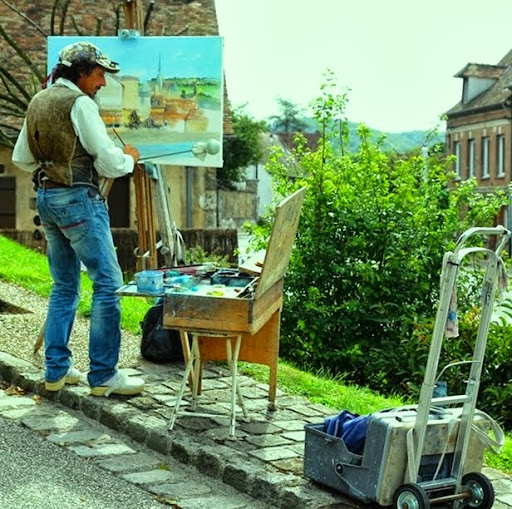
A hundred years ago, this could have been Monet … at Les Andelys
His house, though relatively modest, spreads, and is painted in bright pastel hues, yellow, mauve and air force blue, with window and door lintels painted in a darker variant of the same colour, as though to give Monet definition. It is filled with various paintings of his style and time. The house and the garden he personally tended to with his team of gardeners were as thick with tourists as flies in summer in Oz, with the house and the souvenir shop as competing chops!
We motored on to the old medieval village of Les Andelys with its Castle on the Rock built by Richard the Lionheart, Duke of Normandy, in 1198 to guard nearby Rouen from the French, high above the town. It is what little boys believe castles should look like and the town is full of many board and plaster dwellings with a magnificent stone church that in other places would be a cathedral. Also has lots of bric-a-brac shops for the Paris glitterati and of course my wife imbibed with a porcelain piece that looked like something dropped from the bomb-bay of a Lancaster!
On to Honfleur at the mouth of the Seine, a thriving port town in the 11th Century for trade with Rouen and England, a safe harbor which changed hands a number of times up to the mid-15th Century. It was also a major trading port for Africa and the New World, mainly Canada, and retains much of its unique timber and plaster housing, particularly around its very attractive port, now a basin for rich men’s yachts and trottoir foodies. The fresh mussels get served in tubs almost as large as a beer vat, and around them, people sit shelling, shucking and slurping, building up a dump of mussel shells that resembles a small slag heap.
We passed by a Ferris wheel and a merry-go-round like shadow boxers sparring with the late afternoon crowd at the quayside, an ancient tower besides a lock, the only remnant of medieval fortifications. A kilted piper screeched so loudly that I think people were throwing coins at him with the hope of causing injury while in competition, a Dixieland jazz band started its rendition of Aint She Sweet, to which some folk snapped to attention, probably thinking it was La Marseillaise! Honfleur is a bit like Sophia Loren, beautiful and aged well, and the tourists flock to her like the paparazzi still do to Ms L. It struck us a bit like ‘St Ives en France,’ which might be unfair in both cases, unbelievably picturesque harbours but the same plethora of tack, snooty galleries, traffic snarls, assaulting food smells, and certainly people with seven cats. Mind you, Honfleur had the oldest wooden church in all of France, a monster dating from the 15th Century.
We set our sights for Bayeux, famed for its twin spired cathedral, the home of the Bayeux Tapestry, good Calvados and lovely streets and ancient houses, and for over a month in August 1944, the capital of France, till Paris was liberated. It was all largely untouched by the greatest invasion in history, some of it on beaches a few kilometres to the West and so it did not suffer the almost total flattening as did Caen, 22 kilometres away. Allied ships and aircraft had bombed and shelled the coastal strip on D-Day and also the areas inland, but not so the area in between because they wanted the roads and bridges in tact to move rapidly inland, and beautiful Bayeux was a beneficiary of that strategy. It was also the meeting point for my two days of touring the invasion beaches, the purpose of our visit, almost 70 years after D-Day. Unlike the weather on D-Day, the morning fogs lifted to glorious hot and sunny days and with some shame I tell you that as an old cricketer, I should have taken precautions instead of getting badly blistered lips!
The story of D-Day has been told in thousands of books but it is the individual vignettes, the sights, the fields and now sanctuaries of death, that bring the enormity and sacrifice of it all – troops and civilians – to life, as they should, so that people can be remembered for the courage that just being there evokes. Field Marshal Rommel’s Atlantic Wall, although stronger around the region of Calais, was still formidable in Normandy with integrated systems of heavy guns and machine guns, bunkers and over four million mines (Rommel wanted six million!) as well as obstacles in the sea to tear out the bottom of landing craft. But both sides knew it was about the beaches and either finding a foothold, or as Rommel had planned, throwing the Allies back into the sea. “Believe me, gentlemen, the first 24 hours of the invasion will be decisive,” Rommel told his officers. “For the Allies, but also for the Germans, it will be the longest day, the longest day.”
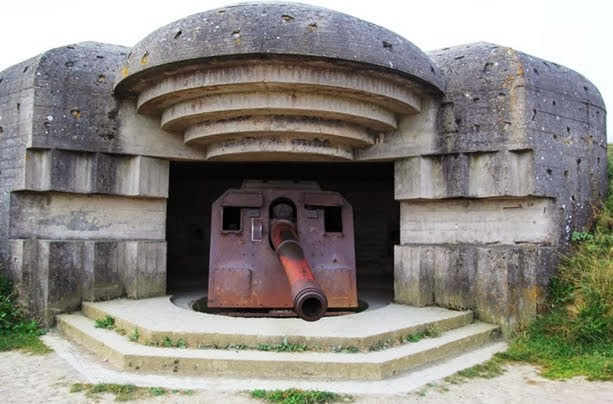
Atlantic Wall guns which fired out to sea all day … and didn’t hit a thing!
My Overlordtour organized by the highly efficient Christele, and under the huge expertise of guide Shaun (formerly of the British Museum’s Churchill War Rooms) for Sword, Gold and Juno beaches, and Dominique, a Frenchwoman of enormous knowledge, for Omaha and Utah beaches, was a greatly rewarding two days, full on from 8.30am to 5.30pm covering well over 100 kilometres.
They set the scene well. The Germans knew ‘something’ was happening but not where. There was an increase in en clair messages into France, things innocuous like, “John has a long moustache; There is a fire at the travel agency.” The invasion due for 5 June was cancelled due to appalling weather and 6 June was marginally better, but they went anyway.
Imagine for a moment, the state of the men in the invading force, a good hot breakfast well before dawn because they might not get a proper meal for days, climbing into a landing craft tossed in six foot waves, and the craft soon full of the nauseous smell of vomit and the equally queasy chemical smell and vertigo from wet arm patches designed to mitigate the effects of gas. And on reaching the beaches, realizing from the fusillade that the defences had not been subdued as expected, the sea a chilling 10 degrees, everything wet in an instant, hundreds of metres to walk unprotected while carrying an average of 30-40 kilos, so as to get to sea walls or dunes which appeared to offer some respite, the beach now full of bodies, blood and confusion. Unbelievable fear which froze minds with the first sighting of death and vicious wounds, the crying for mothers. The average age of the troops just 21. On this sunny day on Juno beach, with a flat sea, it was impossible to imagine.
We started at Ranville (which contains the immaculately maintained Commonwealth War Graves cemetery) where the first paratroops and glider borne troops landed on 5 June, surprising the Germans not expecting an attack in view of the weather. But that same weather scattered troops all over the target area, easy to do in the times before GPS and needing to identify landmarks, usually church steeples and rivers, which on a dark night despite the full moon, saw some cloud cover. Instead of 500 being available to attack the vital-to-destroy Merville Battery, which covered Sword beach, there were only 150, yet the task was done.( The sound and light show in one of the bunkers simulating the attack on Merville by the paras is frightening for civilians like me. The light flashes, percussion so that the whole bunker shakes, and the noise, the noise, is simply unbearable and disorienting, and for us it was without bullets and shrapnel!) The high ground overlooking Caen was thinly seized to allow observation and prevent counter-attack. Major John Howard and his glider troops famously captured the vital ‘Pegasus Bridge’ and prevented its demolition till the landed relief column, led by piper Bill Mullin, and Lord Lovat, carrying his hunting rifle as though ready for fox or grouse, crossed, taking over over and holding the Caen canal approaches.
Museums and graveyards are well maintained and at the Ranville cemetery, an Australian pilot, Ft Lt Henry ‘Lacy’ Smith, was (till now) the last interned there in 2011 after his Spitfire’s wreckage was found at the mouth of the Orne river at Ouisteham, with his remains still inside. He was shot down on 11 June 1944, but was buried with full military honours in 2011, a right of all personnel killed in Normandy although American families were offered the choice to bring their loved ones home, and about a third did. Officers are buried among their men and two contiguous grave stones usually indicate tank or air crew who could not be individually identified.
In the afternoon we travelled first to German strongpoint Hillman, a well dug in bunker complex east of what is now Collville-Montgomery. (The town Collville-sur-Mere was one of the first liberated by the invasion force and wrote to the British Field Marshal seeking his concurrence to the name change. Montgomery, in his usual aloof manner had his staffer write back merely to say “all right” to what others thought a huge honour). The strong-point was identified by the Allies but its strength badly under-estimated and the engineering officer commander, Col Krug held up the British advance for a day, causing many British casualties and preventing the early taking of Caen, a key invasion objective, before surrendering. Krug’s troops came out with “Handes Hoche,” the Colonel’s Batman leading the way while Krug followed carrying two suitcases … so no hands in the air! We learned that many of the troops in the Normandy area were Oosttroopen or German allied troops, and many of them, particularly Poles at Utah beach, were very happy to surrender!
In the late afternoon we visited Arromanches and on the shore and out at sea, saw the concrete caissons which comprising the artificial Mulberry Harbour. Around those on the beach, children played and people sunbaked, watched over by a Bailey Bridge construction mechanism, the former German HQ, a lethal 88cm gun and an armoured car. People queued instead for ice-cream and frits, the war a long time gone. Slightly further south was a Churchill ‘funny’ tank used by engineers, which had rolled and later been buried in a shell hole. The crew leapt for their lives. It was re-discovered in 1976 and two of the original crew were there when it was restored and placed nearby as a permanent memorial in 1977. (Interestingly too, we came across one of the biggest concrete caissons from Mulberry near Zierkzee in Zeeland, the Netherlands. It was towed from Normandy in 1953 in a desperate measure to successfully staunch a breeched dyke that had flooded much of the province, (including a house subsequently purchased by my father)leading to nearly 2000 deaths and much property damage.
Nearby too, is the largest D-Day memorial on the beaches. It is a huge Cross of Lorraine to mark the landing spot of General Charles de Gaulle on 14 June, 8 days after the first landings. He looked around briefly and flew back to the UK that night. Churchill had arrived a day earlier and lunched with Montgomery near the front lines. There is a small plaque at Arromanches.
The following day we went first to a coastal battery near the village of Longues containing the only original German guns in their concrete casemates. They fired out to sea all day, and didn’t hit a thing! We went and stood on Omaha Beach, a beach running many miles, but the actual landings area was quite narrow. The sandy ridge behind the low dunes was heavily mined and there were many machine gun posts that swept both down and along the beach, a great killing zone.
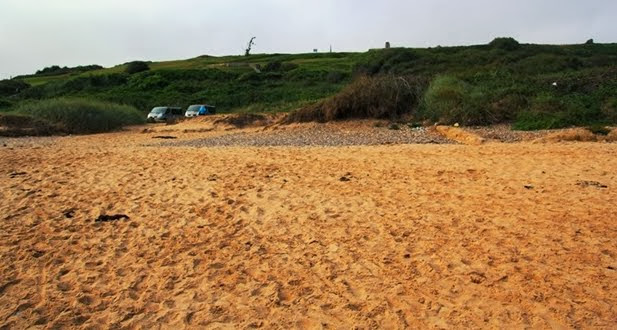
Omaha Beach and the sight facing the Marines when coming ashore
The figures tend to become mind numbing and they only evoke part of the horror, but standing here and looking out, there is a natural inclination to ask the impossible question of, “What would I have done?” A bravery perhaps a foolhardiness we cannot understand, sometimes all in the one incident like the English officer on Gold who seeing his troops in chaos on the beach, held up his umbrella to signify a ‘rallying point’ and was immediately shot dead. In the ‘beautiful sanctity’ of the graveyard behind Collville-sur-Mere, one of 27 war cemeteries in Normandy, there are the graves of nearly “10,000 American boys” and many of their life stories are movingly told in the magnificent museum, always ending with the last video frames, their gravestone and a few heartfelt words. It is a place where every visitor goes quietly and respectfully.
The US had nearly 6,600 casualties on D-Day, most of them on Omaha with Gold, Sword and Juno having nearly 1000 each, and the more poorly defended Utah only 250 although in the area behind Utah, hardened German paratroop units fought fanatically against US paratroopers, many who were killed. Of all the forces, only the Canadians were able to reach their objectives at the end of day one. It is generally agreed that in the Battle for Normandy there were 450,000 Allied casualties, 200,000 German casualties and a similar number of Germans taken prisoner. French civilian casualties, most from allied bombing, number between 15 and 20,000.
We travelled to Pointe de Hoc, known to everyone now who has seen Saving Private Ryan, of the Rangers climbing 30 metre cliffs while ships shells flew overhead to keep the Germans from firing mortars and machine guns on the defenders. So many things went wrong, vital supplies were lost at sea, grappling irons pulled down sections of the cliffs weakened by rain, ladders weren’t long enough, radios failed and re-enforcements went to Omaha because the initial assault had started late, but still the Rangers prevailed, only to discover that the ‘guns’ had been replaced by logs and the real guns were back some distance in the hedgerows, set to rain carnage on Omaha and Utah beaches. As one of the fates of war, the guns had been temporarily left while crews met to consult about the invasion and a small Ranger patrol found them ready but unguarded and blew up their firing mechanisms.
Today, Pointe de Hoc’s casements and bunkers have a golf-course full of hazards look about them as the whole area was carpet bombed and shelled, and after the Rangers got ashore, many places were blown up. There was a steady stream of lookin-peepers, me among them, who went down into the bunkers and looked through the thick concrete firing slit trying to imagine the sight of some 5000 ships that greeted the occupants on the morning of 6 June. It is now American territory and a concrete plinth, unveiled by President Reagan in 1994, stands on top of a casement like a sentinel.
The village of St Mere de Eglise became a target largely because Dakota pilots, disoriented and frightened by heavy flack and a failure to spot pathfinder target, dropped their loads too low and too fast over much of the countryside around Carentan, and some directly over the village. The Germans, already alert because of a house on fire, were in the town square in numbers, armed and tense. And into this mayhem drifted paratroopers of units of the All American 82nd Airborne including paratrooper John Steele, whose parachute caught on the steeple. Wounded, he feigned death hanging in his harness while the battle raged below him, a scene made famous in the movie The Longest Day. Two German spotters in the steeple eventually realized he was alive. One wanted to shoot him, the other said no, so they cut the straps and he tumbled off the roof and on to the cobbles to be captured, but later escape, survived the war and became the hero of Mere St Eglise, returning often to a hero’s welcome till he died in 1969. A mock up of the hanging Steele still graces the village church and nearby is the excellent Airborne museum with its Dakota, Waco glider, and a Sherman tank, all in homage to the 82nd with the famous AA patches, and the 101st Screaming Eagles, who jumped into France on 5 June, 1944.
Interestingly, General Jim Gavin, leader of the 82nd became US Ambassador to France (and reportedly had affairs with Marlene Dietrich and Hemingway’s muse, Martha Gelhorn – he wasn’t called “Jumping Jim” for nothing!) and the leader of the 101st General Maxwell Taylor, became Ambassador to South Vietnam both at their Overlord boss, Dwight Eisenhower’s behest. Both however became fierce critics of his policies as President.
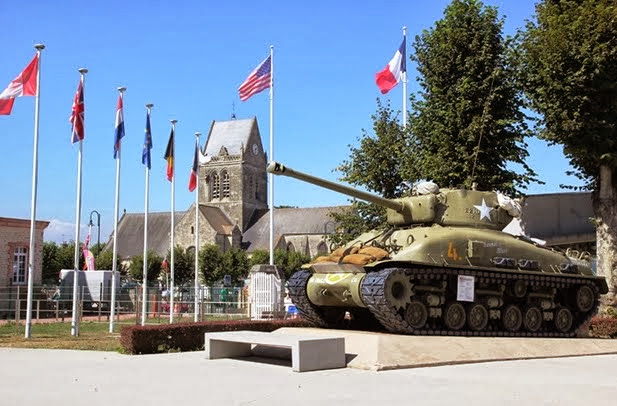
Outside the Airborne Museum, ‘John Steele’ hangs from his parachute.
After an excellent lunch from a popular boulangerie, finished off with a mille feuille, (read Vanilla Slice meets Cream Match) we travelled to the site of bridge over the Merderet River at the La Fiere Farm. The bridge was taken, lost and retaken in counter attacks and with very limited supplies, paratroopers knocked out two captured French (now German) tanks at very close range, a feat of great bravery, with Gamon grenades and held the line till landed troops came. It is beautiful farming country, low and flat with bent willow trees and green gushy grass, raised levees that signify river banks and a railway line, peaceful yet still flanked by a long ago war, and death. It is country that hides its war wounds well. In 1944 the Germans had flooded much of it but the grass and reeds grew through the water, not distinguished from aerial photos, and a number of paratroopers, many already carrying 30-40 kgs and a leg-bag of more supplies, were drowned.
There was one more poignant spot, although it can be argued that all of Normandy is poignant as in all of France, it suffered most damage and loss of life with towns like Caen and St Lo being almost completely smashed. Unlike many of their colleagues, some of the Screaming Eagles landed perfectly in the drop zone. The trouble was some of the front line 6th German Paratroop Regiment were waiting for them, and the fighting, and casualty rate, was heavy. When the Americans secured the village of Angoville au Plain, two medics set up an aid station in the 12th Century church, and they continued ministrations when the Germans recaptured it. Seeing Bob Wright and Ken Moore also treating German wounded, the Germans set their own doctor to assist them. All three continued working each time the village changed hands over the next two days and the pews still contain the stains where blood seeped into the wood. Eighty combatants and one civilian were given rudimentary treatment, and only one died. Both Ken and Bob survived the War and came on a number of post D-Day visits as honoured visitors. They are now both dead. In the centre of the church is a cracked stone where a mortar bomb fell but failed to explode, and stained glass windows commemorate their great bravery and humanism.
The village Mayor told us that now only “old tourists come” and that “the youth are little interested in what happened here.” His sadness reflected our own thoughts. We would head back to homes in places that had never been physically threatened. It was a quiet, reflective trip back to Bayeux.
The actual invasion beaches are well commemorated and signposted with lots of museums and plenty of memorials and explanatory tablets of “what happened here.” Time did not allow a visit to the terrain of the Falaise Pocket where 50,000 Germans were trapped, although many more escaped. Eisenhower described the Pocket as “killing fields out of Dante,” where some of the fiercest fighting was done by the Americans, Germans and the Poles. But in places that we did visit, where significant battles had taken place, Vire and Mortain, there were simply no signs on the main roads which directed one to battle sites. It is rugged, difficult country, well forested with small sharp valleys and in some of those places, small units which were trapped and encircled, fought with great valour. I was sorry that there was not more effort made to point out the locations.
“The War was a long time ago, and for many individuals in France, it was not a time overseen by heroics,” our guide said obliquely. “Some may prefer in fact, that much of it is forgotten. That is not possible on the coast of course, but further inland, you have to know where to look …” and the voice trailed off. Collaboration is something few want to raise, but as another guide said, “They lived among us,” meaning the Germans.
It is a pity that not all battle sites are better signposted for if not, it ‘distorts history,’ as though somehow the sites of some battles do not have the same intrinsic importance. Yet soldiers and civilians died there too and they deserve to be remembered in the same ways as those who were casualties on the beaches. I am glad that I came and saw where men – and women - had come to fight against the evils of Nazism. As the poet, John Donne wrote many centuries ago, “Every man’s death diminishes me, for I am involved in mankind.” My generation is a direct beneficiary of their sacrifice for in growing up, we heard much of our parents talk about the harshness of occupation, deprivations and the aftermath of war. Maybe it is that which makes my generation, and the one that went before it, perhaps more appreciative of what happened on the beaches of Normandy in June 1944, and the places beyond.
Winfred Peppinck is the Tales of the Traveling Editor for Wandering Educators
All photos courtesy and copyright Winfred Peppinck



















